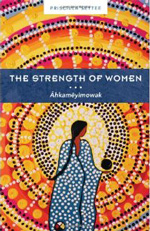
This book pulls back the curtain on a world that may have been invisible to many readers. The real life voices that speak to us here are those of Canadian Aboriginal women. Priscilla Settee, a leading Saskatchewan educator and activist, has collected these words from women who are strikingly diverse in their lifestyles, their beliefs and their backgrounds. Yet they share one common character trait that Settee identifies as âhkamêyimowak. A Cree word, it " …embodies the strength that drives women to survive, flourish and work for change within their communities."
At first, I was startled by the juxtaposition of the fifteen voices who share their lives and their ideas in these forty-six short pieces. Some are essentially essays written in carefully chosen language intended for thoughtful reading, whereas others are memoirs with a distinctly oral quality that sweeps us along with the power of a personal struggle. Some of the speakers are old enough to remember a different time, others so young that the past is a startling discovery. There is a clear message in this crazy quilt of voices: these women cannot be forced into the narrow stereotypes within which they have often been confined. This is only clear when they speak for themselves.
That's not to say that there aren't many threads of thought and experience shared among them. Settee has gathered the writings into five general topics. Within these, the women express a world of experience, some of it marvelous, some of it heartbreaking, all of it edifying. The first section, Beginnings, is the most difficult. It includes childhoods marked by the brutal residential schools initiative (also practiced in the United States and Australia). By force of law, young children were taken from their homes and sent to boarding schools where they were taught by white teachers, often missionaries, to think of their families as savages.
This form of genocide in the guise of assimilation is no longer practiced; however the damage done to the parents and grandparents of today's First Nations people is incalculable. Here are the roots of the alienation, abuse, fragmented families and suicide discussed in many of the stories. After these dark beginnings, the following sections of the book are like a stairway into the light, as the narrators tell their stories of survival through Work, Art, Spirit and Community. Each one speaks of the search for identity and community and the sometimes circuitous path toward a true home.
Traveling through this slim volume will open your eyes to the experiences of people who are as much like you as they
are different. At times, you might want to look away—the pain is that raw—and yet I'd advise you to keep
reading. There is always hope ahead in these stories of courage and healing.

Coteau Books, paperback, 9781550504569
